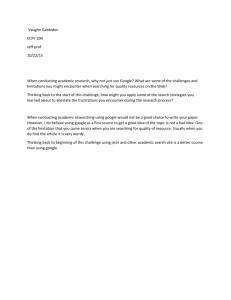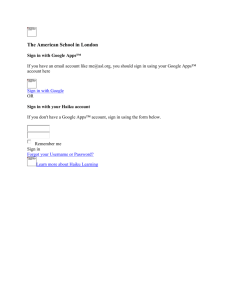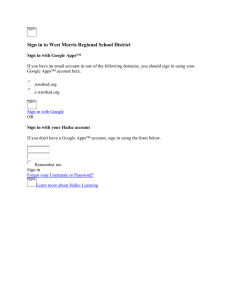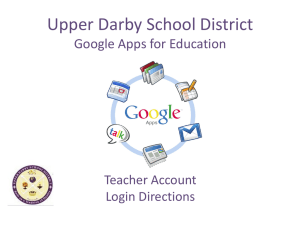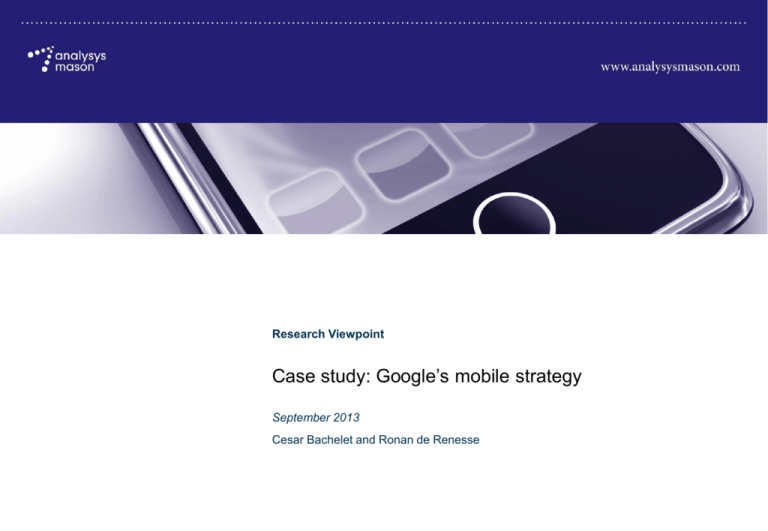
Case study: Google’s mobile strategy
Research Viewpoint
Case study: Google’s mobile strategy
September 2013
Cesar Bachelet and Ronan de Renesse
© Analysys Mason Limited 2013
Case study: Google’s mobile strategy
Executive summary
Implications for operators
Google’s strategy and business model
Google’s mobile service portfolio
Assessment of Google’s prospects in mobile
About the authors and Analysys Mason
© Analysys Mason Limited 2013
2
Case study: Google’s mobile strategy
3
Executive summary
Google has made a wide range of acquisitions during the last decade to become a key player in the mobile value chain, having
successfully translated its dominance in online search to mobile search. In particular, the Android platform enables it to extend the
reach of a wide range of services, all of which are ultimately geared towards growing its advertising business, which accounts for
the bulk of its revenue.
Google’s presence across the mobile value chain is a key asset, which its competition has yet to match.
The scale of Android maximises the reach of its services and advertising products on mobile. We expect the number of
worldwide Android smartphone shipments to more than double, from fewer than 390 million in 2012 to more than 800 million in
2017. The openness and flexibility of Android represents both a strength and a weakness. It gives consumers greater choice and
control, but the operating system is fragmented because of the proliferation of different versions and vendor customisations,
resulting in an inconsistent user experience.
The Motorola acquisition has helped Google gain a foothold in the hardware market. Motorola’s position in the smartphone
market is relatively weak, but the acquisition offers Google the expertise and intellectual property it needs to showcase its
services in a vertically integrated environment and defend its Android partners in litigations if necessary. However, too much
emphasis on hardware development may damage those same relationships.
Google search on mobile and the acquisition of AdMob in 2009 has made Google the leader of the mobile advertising market.
We estimate that about 10% of Google’s revenue came from mobile advertising in 2012, compared with about 5% in 2011.
Google’s advertising revenue has been increasing, but it has not kept pace with the growth in the number of aggregate paid
clicks (paid clicks related to ads served by both Google and its Network members) because of the decline in the average costper-click, which is partly attributed to the increasing proportion of clicks from mobile devices.
Google is undoubtedly an established leader in the mobile market but it faces increasing competition from various sides of the value
chain – Apple on the device side, Facebook on the services side and Microsoft on the software side. This report assesses Google’s
ability to maintain its lead and transform in order to better monetise its immense user base.
© Analysys Mason Limited 2013
Case study: Google’s mobile strategy
Executive summary
Implications for mobile network operators
Google’s strategy and business model
Google’s mobile service portfolio
Assessment of Google’s prospects in mobile
About the authors and Analysys Mason
© Analysys Mason Limited 2013
4
Case study: Google’s mobile strategy
5
Implications for mobile network operators
Positive
Google has driven the demand for mobile data services by
offering a growing range of mobile content and applications,
thus benefiting mobile operators.
Google has driven the penetration of smartphones and
tablets by providing an alternative to the Apple ecosystem
through Android. Devices such as the Chromebook range of
laptops, which use Google’s Chrome operating system, also
drive the demand for connectivity on the move. Competition
between mobile operating systems also benefits both
consumers and mobile operators by bringing more choice
and innovation, while driving down the price of devices.
Negative
Services such as Google Voice, an OTT communications
app, cannibalise mobile operator voice revenue.
Google’s extensive collection of data generated through its
interactions with consumers and dominant share of the
mobile advertising market reduce operators’ opportunities in
‘big data’ and mobile advertising.
Google disintermediates mobile operators in the device
distribution value chain by selling its own SIM-free, unlocked
devices produced in conjunction with various partners, such
as the Nexus range of smartphones, directly to consumers.
Emerging devices such as Google Glass promote an ever
more connected lifestyle, which will stimulate further demand
for connectivity.
Google already competes against fixed operators within the
limited footprint where it has deployed its Google Fiber
service. It could potentially deploy comparable mobile
services if it acquires the relevant spectrum.
Operators are in a position to make use of Google’s need to
increase its reach in emerging markets where Internet
penetration is low. For example, Google Free Zone gives
mobile customers in emerging markets zero-rated data
access to Google services.
Google can disintermediate mobile operators by providing
services to consumers that mirror those operators offer, such
as satellite navigation (Google Maps), mobile music (Google
Music) and video (Google Play Movies & TV).
© Analysys Mason Limited 2013
Case study: Google’s mobile strategy
Executive summary
Implications for operators
Google’s strategy and business model
Google’s mobile service portfolio
Assessment of Google’s prospects in mobile
About the authors and Analysys Mason
© Analysys Mason Limited 2013
6
Case study: Google’s mobile strategy
7
Google’s presence throughout the mobile value chain drives its
advertising business
Google offers a wide range of mobile products and services
(see below), all of which are ultimately geared towards
extending the reach of its advertising business, which
accounts for the bulk of its revenue. It is therefore well
positioned to monetise a wide range of consumer interactions
on mobile devices through advertising.
Content: The Google Play store offers a wide range of
digital content, including e-books, games, music and
video, to Android device users. YouTube video content is
available on other operating systems.
Applications and services: Google complements its core
search functionality with a wide range of apps and
services, including communications, maps and mobile
payments, some of which are available to users of other
mobile operating systems.
Operating systems: In 2007, Google was a founding
member of the Open Handset Alliance (OHA), a
consortium that aims to develop and promote open
standards for mobile devices, based on the Android
operating system which Google acquired in 2005. Google
also developed its Chrome OS for Chromebook laptops.
Devices: Google acquired Motorola in 2011, giving it a
foothold in the mobile device market. It also partners with
various manufacturers to sell Google-branded devices,
such as Nexus smartphones and tablets.
© Analysys Mason Limited 2013
Figure 1: Google’s product and service categories [Source: Analysys Mason,
2013]
Advertising
Content
Apps and
services
Google advertising
Google Play
content and
YouTube
Apps &
services
Third-party apps
and services
Google apps and
services
Operating
systems
Android-powered
devices
Devices
Third-party
content
Devices with
other operating
systems
Case study: Google’s mobile strategy
8
Google remains heavily dependent on advertising in spite of its
acquisition of Motorola
Figure 2: Google’s quarterly revenue split, 2Q 2011–2Q 2013 [Source:
Google, Analysys Mason, 2013]
16
Google started including revenue from Motorola during the
second quarter of 2012, once the acquisition had been
finalised. In the second quarter of 2013, Motorola
generated nearly USD1 billion in revenue, accounting for
just 7.1% of total revenue.
14
Revenue (USD billion)
A comparison of Google’s quarterly revenue for the second
quarter of 2013 with the equivalent period in 2011 shows that
its overall revenue increased by 56.3%, from USD9 billion to
USD14.1 billion.
12
10
Revenue classified as ‘other’ more than trebled, from
USD310 million to just over USD1 billion. This category
includes revenue from content sales, hardware sales other
than Motorola, as well as Google’s services to enterprises,
such as the Google Cloud Platform. Its share of total
revenue more than doubled, from 3.4% to 7.4% between
the second quarters of 2011 and 2013.
8
6
4
2
0
2Q 3Q 4Q 1Q 2Q 3Q 4Q 1Q 2Q
2011 2011 2011 2012 2012 2012 2012 2013 2013
Motorola Mobile
Other
Google Network members' websites advertising
Google websites advertising
© Analysys Mason Limited 2013
Advertising revenue, which is derived from a combination
of Google and third-party websites, increased by 38.4%,
from USD8.7 billion to USD12.1 billion. Advertising’s share
of revenue declined from 96.6% to 85.5%, but it still
accounts for the bulk of Google’s revenue.
Case study: Google’s mobile strategy
9
The growth in mobile advertising has had both positive and negative
implications for Google
20%
10%
0%
–10%
Aggregate paid clicks
Advertising revenue
© Analysys Mason Limited 2013
2Q 2013
1Q 2013
4Q 2012
3Q 2012
2Q 2012
–20%
1Q 2012
However, since the fourth quarter of 2011 the year-on-year
increase in quarterly revenue has lagged behind the yearon-year increase in the number of aggregate paid clicks,
because of the year-on-year decrease in the average costper-click. A particular concern is that the average cost-perclick is lower on mobile devices than on computers and
tablets, which could undermine both revenue growth and
profitability as Google increasingly becomes dependent on
mobile advertising as revenue source.
30%
4Q 2011
The increase in aggregate paid clicks resulted in year-onyear growth for Google’s quarterly advertising revenue.
40%
3Q 2011
The year-on-year increase in the number of aggregate
paid clicks during each quarter between the second
quarter of 2011 and the second quarter of 2013 can partly
be attributed to the growth in mobile advertising.
50%
2Q 2011
The growth of mobile advertising has had benefits and
drawbacks for Google.
Figure 3: Year-on-year change in aggregate paid clicks, average cost-perclick and advertising revenue, 2Q 2011–2Q 2013 [Source: Google, Analysys
Mason, 2013]
Year-on-year change
We estimate that about 10% of Google’s revenue came from
mobile advertising in 2012, compared with about 5% in 2011.
During the company’s earnings call for the third quarter of
2012, CEO Larry Page indicated that it reached a revenue run
rate of USD8 billion for mobile advertising and Google Play
sales, up from USD2.5 billion in the third quarter of 2011.
Average cost-per-click
Case study: Google’s mobile strategy
10
However, the Android ecosystem represents a good opportunity for
Google to diversify its revenue
Figure 4: Worldwide annual smartphone shipments by operating system,
2007–2017 [Source: Facebook, Analysys Mason, 2013]1
Since the launch of the OHA in 2007, shipments of Androidpowered smartphones have increased massively.
In 2008, 1.2 million Android-powered smartphones were
shipped, representing a mere 0.9% of total smartphone
shipments.
1.4
Shipments (billion)
1.2
By 2011, this had increased to 228.6 million shipments,
amounting to a 46.5% share of the total. Android had
become the most popular smartphone operating system,
ahead of Apple iOS (18.9%) and Symbian (14.9%).
1.0
0.8
In 2012, the number of Android smartphones shipped had
reached 389.9 million, accounting for a clear majority of
smartphone shipments with a 56.4% share.
0.6
0.4
0.2
iOS
Symbian
Windows Phone
2017
2016
2015
2014
2013
2012
2011
2010
2009
2008
2007
0.0
Android
BlackBerry
Other
In our smartphone forecasts,1 we anticipate that 802.4 million
Android smartphones will be shipped in 2017, representing
58.7% of the total. This should result in a substantial increase
in non-advertising revenue for Google, mostly from hardware
(smartphones, tablets, and laptops) and content sales
(mostly from its Google Play range of services).
As of June 2013, 900 million Android devices (smartphones
and tablets) had been activated, and CEO Larry Page
indicated that 1.5 million devices were activated daily.
1
1
The ‘Other’ category includes operating systems such as Bada, LiMo, Tizen and B2G.
© Analysys Mason Limited 2013
See Smartphone markets: worldwide trends, forecasts and strategies 2012–2017. Available
at www.analysysmason.com/smartphone-forecasts-2012.
Case study: Google’s mobile strategy
11
Android also increases Google’s ability to compete with Apple and
Microsoft
As an open mobile operating system, Android offers both
consumers and vendors high levels of choice and control,
through a broad range of handsets and the ability to
customise the user interface. This is in contrast to the main
competing mobile operating systems, notably Apple iOS and,
to a lesser extent, Microsoft Windows Phone.
However, this flexibility also represents a weakness, because
it has led to fragmentation, which in turn has resulted in an
inconsistent user experience. This is because of the
inconsistent approach to updates (resulting in many different
versions of Android being used) and vendor customisations.
Figure 5: Levels of choice and control offered by main mobile operating
systems [Source: Analysys Mason, 2013]
High
Android
Level of
control by
consumers
Windows Phone
Apple iOS
Low
Low
Level of choice for consumers
© Analysys Mason Limited 2013
High
Figure 6: Characteristics of main mobile operating systems [Source:
Analysys Mason, 2013]
Android
Apple iOS
Windows
Phone
Choice of
handsets
High – Wide range
of handsets from
different vendors
Limited – only
Apple iPhone
range
Medium – Mostly
Nokia Lumia
range, but
various others
available
Price points
From budget to
high-end
High-end only
From budget to
high-end
Key handset
vendor(s)
HTC, Huawei, LG,
Motorola,
Samsung, ZTE
Apple only
Nokia, Samsung,
HTC
Level of
control by
OS vendor
Low – vendors can
add their own UI
(HTC Sense, for
example)
Very high –
software is
totally integrated
with hardware
High – Microsoft
specifications
have to be
followed
Number of
apps
High (1 million in
July 2013)
High (900 000 in
June 2013)
Low, but
increasing
(175 000 in
September
2013)
Comments
User experience
can vary
significantly,
because of
different versions
of Android
Control
guarantees
consistent user
experience
Control
guarantees
minimum
standards
Case study: Google’s mobile strategy
12
Android has enabled Google to establish itself in the hardware space
Google is involved in the mobile device value chain in various
ways.
Android: Google provides the most popular smartphone
operating system, and it is also gaining market share for
tablets. Through Android, Google collaborates with most
mobile device vendors, many of which have opted to add
their own UI, as vendors are free to customise Android.
Nexus range: Google has collaborated with various
vendors in the Android ecosystem, such as Asus, LG
Electronics and Samsung, to create its Nexus range of
SIM-free smartphones and tablets, which are flagship
devices for Android, using the latest ‘Vanilla’ versions of
the operating system.
Google Experience devices: These are ‘Google Play’
editions of flagship Android devices (such as the HTC
One), featuring a ‘Vanilla’ version of Android.
Motorola: Following its acquisition of Motorola, Google
refrained from favouring its ‘in-house’ vendor and
developing more tightly integrated hardware and software.
Motorola is simply a vendor of Android devices. Motorola’s
share of the worldwide handset market had declined to less
than 2% by the end of 2012. Google needs the commitment
of other vendors for Android to succeed. Google acquired
Motorola for its patents, rather than its devices.
© Analysys Mason Limited 2013
Figure 7: Google’s involvement in the device value chain [Source: Analysys
Mason, 2013]
Hardware
OEM
partnerships
Software
Android
Nexus, Google Experience
devices
Motorola
Case study: Google’s mobile strategy
Executive summary
Implications for operators
Google’s strategy and business model
Google’s mobile service portfolio
Assessment of Google’s prospects in mobile
About the authors and Analysys Mason
© Analysys Mason Limited 2013
13
Case study: Google’s mobile strategy
14
Gathering consumer data is at the core of Google’s mobile service
strategy
Figure 8: Google’s service strategy [Source: Google, Analysys Mason, 2013]
E-commerce
Google Wallet,
Google Shopper
Communications
Location
Google Voice,
Gmail, Hangouts
Google Maps,
Google Goggles
Google+
Search-based advertising is the essence of Google
monetisation strategy. Capitalising on its leading position
among desktop search engines, where it had 71% worldwide
market share in August 2013, Google has successfully
extended its dominance to mobile search engines, with a
90% worldwide market share in August 2013.1
From its position as the ‘gateway to the Internet’ as the
world’s most-visited website,2 Google has extended its range
of services, most of which are free to consumers, to gather
consumer data.
The services include maps and navigation, social
networking (Google+), intelligent personal assistant
(Google Now), communications (Gmail and Google Voice),
m-commerce (Google Shopper and Google Wallet),
content and applications (Google Play) and image
recognition (Google Goggles).
Google has collected a large amount of consumer data, but it
lacks the social elements to link this information to individuals
and their peers. Google+ aims to fill that gap.
Google Search
1
Net Applications (Aliso Viejo, CA, 2013), Market Share Reports. Available at:
http://www.netmarketshare.com/.
2
Alexa Internet (San Francisco, CA, 2013), Top Sites. Available at:
http://www.alexa.com/topsites.
© Analysys Mason Limited 2013
Google gains valuable information by generating more
interactions with consumers, including their preferences,
interests, location and transactions. These can then be
monetised by enabling advertisers to deliver more- targeted
advertising in Google Search.
Case study: Google’s mobile strategy
15
Google+ is Google’s response to Facebook
Google is a relative latecomer to the social networking space,
launching Google+, initially as an invitation-only service, in
June 2011. Facebook, launched in 2004, had already gained
more than 700 million active users by then.
Google+ enables Google to gain additional data about users
that it had lacked – their connections with other users – and
creates additional opportunities for engagement with its
services.
Google+ was opened to all in January 2012.Google
accelerated growth by incorporating the creation of a
Google+ account within the registration process for a Google
account. The service had gained more than 500 million
registered users by December 2012.
Core elements of Google+ include ‘Stream’, which is similar
to the Facebook Wall, where users can see all the content
that other users share with them, and ‘Circles’, a way to
organise contacts into groups, similar to Facebook Friends.
Google+ also offers a range of complementary services, such
as Hangouts, a video chat service, and Google+ Local, which
combines user-submitted reviews with more formal reviews
from Zagat, which Google acquired in September 2011.
Compared to Facebook, Google+ offers more control and
granularity for sharing content, is (surprisingly) advertisingfree and integrates with a much wider range of services.
© Analysys Mason Limited 2013
Figure 9: Selected Google+ services [Source: Google, Analysys Mason,
2013]
500 million
registered Google+
users, of which
235 million use the
features
Circles
Google+
Search
Google+
Core
Google+ Communities
elements
Stream
Messenger
(IM)
(135 million
active
users)
Hangouts
(video chat)
Google+
Events
Google+
Local
Case study: Google’s mobile strategy
16
Google’s recent acquisitions have mainly focused on enhancing its social
and commerce capabilities [1]
Google has made numerous acquisitions to consolidate its position within the mobile ecosystem, the major ones being Android for
its mobile operating system in 2005, AdMob for its mobile advertising platform in 2009 and Motorola Mobility for its patents in 2011
(see Figure 10 on next slide for detailed information about Google’s acquisitions).
Most of its recent acquisitions have focused on the following strategies.
Building its social capabilities: Google acquired both Milk and Meebo in 2012 to bring enhancements to Google+, the social
networking service it launched in 2011. In 2013, it acquired Waze, bringing user-submitted information to Google Maps.
Strengthening its position in m-commerce: The acquisitions of TxVia, Incentive Targeting, and Channel Intelligence enabled
Google to enhance its commerce services for consumers and retailers.
Enhancing Android: The acquisitions of Viewdle and Bump enable Google to bring more features to Android and some of its
other services.
Emerging technologies: Google’s acquisition of WIMM Labs, one of the first companies to launch a smartwatch in 2011, boosts
its presence in the emerging wearable technology segment.
© Analysys Mason Limited 2013
Case study: Google’s mobile strategy
17
Google’s recent acquisitions have mainly focused on enhancing its social
and commerce capabilities [2]
Figure 10: Selected Google acquisitions, 2012–2013 [Source: Analysys Mason, 2013]
Company
Date
Description
Rationale for acquisition
WIMM Labs
2012
Wearable technology
Enables Google to enter emerging
smartwatch market
Milk
March 2012
Mobile development lab
To gain product and design expertise to
enhance Google+
TxVia
April 2012
Mobile payments
Enhancing Google Wallet
Meebo
June 2012
Toolbar featuring chat, content sharing and
advertising
Enhancing Google+
Viewdle
October 2012
Facial recognition technology
Could be integrated within Android
Incentive Targeting
November 2012
Targeted marketing and coupon company
Used to enhance Zavers, a couponing and
promotion solution for retailers
Channel Intelligence
February 2013
E-commerce solutions
The company was a Google Shopping launch
partner, and provides the underlying
technology
Waze
June 2013
Community-driven mapping application
Bringing additional functionality to Google
Maps
Bump
September 2013
Mobile data-sharing application
Could be integrated within Android
© Analysys Mason Limited 2013
Case study: Google’s mobile strategy
18
Google is aiming for dominance of the apps market with Google Play
Google Play (initially launched as Android Market) is now
vying with Apple’s App Store for dominance of the apps
market, despite being launched three months later, in
October 2008.
Figure 11: Google Play products and services, September 2013 [Source:
Google, Analysys Mason, 2013]
In June 2013, Apple announced that it had 900 000 apps,
whereas Google reached 1 million apps in July 2013.
In June 2013, Apple announced that 50 billion apps had
been downloaded, while Google stated that more than 50
billion apps had been downloaded by July 2013.
Content
Google charges developers a one-off USD25 registration fee,
as well as a 30% transaction fee per app sold, which adds to
the revenue it generates from consumers.
In addition to apps, most of which are from third-parties,
Google Play offers a wide range of content, including ebooks, magazines, music, video (movies and TV series) and
games. Availability of different types of content varies
between countries. YouTube is also available on mobile
devices via an app. Third-party content, such as Netflix, is
also available through an app.
Google’s content services vie for the consumer’s attention on
smartphones in particular, with comparable operator and
vendor-installed services. Having been late to market with
content services, Google is not in as strong a position as
others, such as Apple, Netflix or Spotify.
© Analysys Mason Limited 2013
•
•
•
•
•
Play Books
Play Games
Play Magazines
Play Movies & TV
Play Music/Play Music
All Access
Third-party
content
YouTube
Apps &
services
Third-party apps
Apps
Google apps
Case study: Google’s mobile strategy
19
The recent acquisition of Waze adds a social dimension to Google Maps, a
major enabler of location-based services
Figure 12: Waze integration within Google Maps [Source: Google, 2013]1
Google Maps has been continuously improved since its
launch in 2005. It is complemented by related services such
as Google Street View, and used to underpin location-based
services such as Google Transit, a public transport route
planner now fully integrated within Google Maps; business
listings; and the Google Maps Navigation service. Initially
released in the USA as part of Android 2.0 Éclair on the
Motorola Droid smartphone in November 2009, its availability
was extended to Europe in 2010. As a free service, it
disrupted the satellite navigation market, which had been
dominated by paid-for dedicated devices and services.
In June 2013, Google acquired Waze, a navigation application
that features real-time user-submitted information, such as
details of traffic jams or details of local events. Waze has also
offered location-based advertising since November 2012. The
Federal Trade Commission and the Office of Fair Trading are
investigating the acquisition because of competition concerns,
but Google nevertheless began integrating Waze functionality
into Google Maps in August 2013.
1
Image courtesy of Google.
© Analysys Mason Limited 2013
The acquisition of Waze creates a combination of community
and cartography, which lays the foundation for a wide range
of social location-based services that are underpinned by
Google’s dominant position in search. This gives it an
advantage over comparable services, such as HERE from
the newly combined Microsoft/Nokia entity.
Case study: Google’s mobile strategy
20
Google will integrate Google Shopping, Google Search and Google Wallet
more closely for an intuitive m-commerce experience
In August 2013, Google retired its standalone Google
Shopper mobile app in in favour of a more integrated
approach that pulls together distinct services.
Figure 13: Integration of Google consumer m-commerce services [Source:
Google, Analysys Mason, 2013]
Google Search: A standard search for a product or
service brings up advertising from suppliers, as well as
normal search results.
M-commerce
Google Shopping: Originally launched as Froogle in
2002, the service provides pricing comparisons for
products and services, following a query from the user.
Google Wallet: A mobile payment system launched in
September 2011, which enables users to store payment
credentials and details of loyalty programs on their
smartphones for transactions.
Google
Shopping
Google
Search
Google
Wallet
These services are underpinned by Google Location
Services, which determine the user’s location, boosting clickthrough rates for advertising because of greater relevance.
However, Google Wallet is currently only available in the
USA, and users are limited to 300 000 merchant locations
equipped with suitable contactless terminals. Google has
struggled to establish itself in other countries, because other
players, notably consortia of operators and banks, aim to be
the default mobile payment solution, as different virtual
wallets are unlikely to coexist on the same device.
© Analysys Mason Limited 2013
Google Location Services
Case study: Google’s mobile strategy
21
Google has enhanced its advertising products by opening access to some
of its most popular services, such as Gmail
Figure 14: Selection of Google advertising solutions [Source: Google,
Analysys Mason, 2013]
At the second quarter of 2013, only 26.5% of Google’s
advertising revenue came from third-party websites to which
it delivers ads, the rest coming from its own Internet
properties such as www.google.com and YouTube.
Google
AdWords
Advertisers bid for placement in Google’s
own websites (like www.google.com) and
other websites from other companies
members of the Google AdSense network
such as AOL search and Ask.com.
Despite leading the mobile advertising market in terms of
revenue, Google’s mobile advertising products, which it
acquired through AdMob, did not bring the revenue growth
that it had hoped for. Like Facebook and other Internet firms
relying on online advertising, Google finds it difficult to offset
the revenue losses associated to fixed–mobile substitution.
AdMob
Google acquired AdMob in 2009 for
USD750 million.
From May 2013, AdMob was rebuilt to
integrate with the AdSense network,
extending online ads delivery to apps and
mobile websites.
In response to stagnating revenue from third-party websites
and apps, Google is increasing advertising on its own
services.
Google
Offers
Following a failed bid to acquire Groupon,
Google launched its own equivalent in May
2011. The service is integrated with Google
Wallet, a mobile payment platform currently
only available in the USA.
© Analysys Mason Limited 2013
It has been increasing advertising presence on YouTube
since 2007.
It introduced ads in Gmail tabs in July 2013. The ads look
like emails, but only appear in the ‘promotions’ tab.
Advertisers are looking for more consumer data, which
Google is in a good position to offer. Google+ forms an
essential part of contextualising this data in order to increase
advertising spend.
Case study: Google’s mobile strategy
22
Key future opportunities for Google include m-commerce and integrated
multi-screen advertising
Figure 15: Growth opportunities for Google [Source: Analysys Mason, 2013]
Service
categories
Description
Status
Revenue potential
Android
Google is well positioned to develop the Android ecosystem, which will
enable it to generate additional revenue from devices and services.
However, it faces competition from Apple, which typically attracts highervalue mobile customers, and a greater threat from Microsoft, following its
acquisition of Nokia and the growth in Windows Phone’s market share.
As of June 2013, a total
of 900 million Android
devices had been
activated.
Medium – revenue per device is low,
but the sheer scale of Android turns
this into a large opportunity.
M-commerce
Google has been strengthening its m-commerce capabilities, and is
therefore well-placed to capitalise on the growth of m-commerce (for
example, through location-based services). However, Google’s database of
credit card details is much smaller than Apple’s, which has been selling
content for a decade via its iTunes Store. Google only introduced support
for paid-for applications within Android Market (now Google Play) in 2009.
Google Wallet is
currently only available
in the USA, and Google
has struggled to
establish itself
elsewhere.
Large – particularly if Google manages
to gain international traction for Google
Wallet. Otherwise it will be hampered
by the lack of a mobile payment
solution.
Integrated
multi-screen
advertising
Google aims to increase average cost-per-click through integrated and
more targeted services (location-based, for example) to advertisers. Google
has recently been pushing its Enhanced Campaigns multi-screen approach
to advertisers, but a key challenge will be to offer an integrated multi-screen
solution that still gives advertisers sufficient flexibility to tailor campaigns for
specific devices.
Google benefits from its
dominant position
among search engines.
Medium – Google is already the leader
in online and mobile advertising, and
would consolidate its position through a
fully integrated solution to advertisers,
but the revenue uplift that it would
provide is unproven.
Social
networking
Google has made a good start with its Google+ social networking service.
However, Google still lags far behind Facebook, which had more than
1 billion active users in December 2012. Facebook has been expanding its
range of services to increase stickiness, and benefits from having far more
data about peoples’ contacts.
As of December 2012,
Google+ had 500 million
accounts and
135 million active users.
Small – as proven by Facebook, it is
very difficult to monetise social
networking. The revenue that Google+
would generate is more likely to be
indirect.
© Analysys Mason Limited 2013
Case study: Google’s mobile strategy
Executive summary
Implications for operators
Google’s strategy and business model
Google’s mobile service portfolio
Assessment of Google’s prospects in mobile
About the authors and Analysys Mason
© Analysys Mason Limited 2013
23
Case study: Google’s mobile strategy
24
Google’s ubiquitous presence at key points in the mobile value chain will
give it a significant advantage over its main competitors
Figure 16: Position of Google and its main competitors in the mobile value chain [Source: Analysys Mason, 2013]
Key asset
Level of control
Mobile presence
Mobile monetisation
Access to customer
data
Comments
Google
Search capabilities Strong. Mainly built on
and a vast array of acquisitions and inonline services
house development
(Gmail, YouTube)
Very strong. Android
represent 56% of
smartphone sales in
2012
Strong. Generates over
EUR1 billion revenue
from search and display
mobile advertising
Unrivalled access and
ability to capitalise on
that access
Undoubtedly bestpositioned in mobile but
too focused on
smartphones
Apple
Excellent
hardware and
content portfolio
(apps)
Very strong. In-house
focus
Medium. Market
leader in high-end
smartphone segment
Very strong. Largest
Potential to do more in
margins on device sales. support of a strong
Focus is on increasing
user experience
the value of devices
Hardware-focused
business model likely to
continue but extending
beyond high-end
Amazon
Online retail and
Kindle product
range
Medium. Lacks control
of mobile experience
and device value
chain, distribution
Poor but strong
potential for growth
Weak, not necessary.
Focus on increasing
overall e-commerce
revenue
Strong, has access to
purchase habits and
large credit card
database
Ability to seriously disrupt
the mobile market with
new business model
Facebook
Social networking
services
Strong. All products
built and managed inhouse
Very strong.
819 million mobile
users at June 2013,
most-used
application
Medium. Advertisingbased, growing fast
Strong, but some
concerns about
privacy and scalability
Has become a major
mobile company from
user/service perspective
but needs to prove
monetisation ability
Microsoft
Nokia, Windows,
Skype and Bing
Strong. Mainly built on
acquisitions and inhouse development
Poor. Small market
share for Windows
Phone. Gained
stronger presence
with Nokia acquisition
Weak on the consumer
front, relatively strong on
technology and patent
portfolio
Relatively weak
Relatively weak in mobile
but far from giving up.
What it does with Nokia in
the low-end handset
segment will be key
© Analysys Mason Limited 2013
Case study: Google’s mobile strategy
25
Rating of Google’s prospects in the mobile market
Figure 17: Rating of Google’s prospects in the mobile market [Source: Analysys Mason, 2013]
Success factor
Comments
Brand strength
Huge installed base of Android users worldwide
The brand has some fragility, particularly concerning privacy and data security,
as well as customer trust with regard to payments
User experience
Has continuously expanded and improved its range of services
Improvements to Android have resulted in a better user experience, but market
fragmentation and openness leave little room for control
Google’s ecosystem of hardware, software and services is geared towards
driving advertising revenue from mobile devices
Nevertheless, Google needs to reduce its dependence on advertising
Fit with business model
Leverage in the value chain
Overall prospects
Key: = Weak; = Strong.
© Analysys Mason Limited 2013
Google has the largest company presence throughout the mobile value chain,
which is an excellent asset in the current market
However, it faces challenges in its vendor partnerships as a result
Google is well-established in the mobile market and is very unlikely to be
displaced by its strongest competitor in the short and medium term
The intelligent use of ‘big data’ in services such as Google Now paves the way
for highly personalised and timely advertising, resulting in great potential for
higher revenue
Score
Case study: Google’s mobile strategy
26
SWOT analysis for Google in the mobile market
Strengths
Weaknesses
Large-scale, cross-platform, worldwide brand with high penetration
rates among Internet users. It is at the heart of the Android
ecosystem, the most popular mobile operating system in the world.
Lacks network infrastructure/back-end control (unlike operators).
Strong position with advertisers and businesses, which it can use
for mobile monetisation. Google currently leads the mobile
advertising market in terms of revenue.
Concerns about privacy and security mean that some users are
reluctant to commit further to Google.
Possesses a large amount of consumer data gathered through
interactions with its wide range of services.
Opportunities
Sufficient brand strength and installed base to shape the market.
The growth of the Android ecosystem will generate additional
revenue from hardware and services, reducing Google’s
dependence on advertising.
Google has not yet fully exploited its consumer data. Google Now
and Google + could offer massive opportunities, as the foundation
for highly targeted, personalised cross-device advertising
Further acquisitions to gain required expertise and/or extend its
reach.
© Analysys Mason Limited 2013
Its dependence on advertising revenue means that Google is
exposed to fluctuations in advertising spend.
A latecomer to social networking, it lags far behind market leader
Facebook. Google also lacks the social context to the data it holds.
Its focus on smartphones means that it is missing out on
opportunities in emerging markets.
Threats
Strong pressure to monetise services could provoke a customer or
merchant/advertiser backlash.
Major platform players such as Apple, Facebook and Microsoft
could limit Google’s ability to compete.
Its large user base means that it needs to manage many different
versions of its products and address different consumer needs. This
fragmentation can lead to exponential operating costs, which would
seriously affect profit margins in the future.
Case study: Google’s mobile strategy
Executive summary
Implications for operators
Google’s strategy and business model
Google’s mobile service portfolio
Assessment of Google’s prospects in mobile
About the authors and Analysys Mason
© Analysys Mason Limited 2013
27
Case study: Google’s mobile strategy
28
About the authors
Cesar Bachelet (Senior Analyst) has over 20 years’ experience of the telecoms industry, and specialises in tripleplay services, with a focus on pay TV, as well as emerging services and devices within the digital home. He has
conducted research and delivered presentations on a wide range of topics, including fixed voice, broadband and
video services, bundling and convergence strategies. He also contributes to various media-focused Consulting
projects. Before joining Analysys Mason, Cesar worked for various analyst companies, including Ovum. Prior to this,
he worked for telecoms operator BT, where he held a range of positions, including those of Competitor Analyst in
the Consumer Division (now BT Retail) and Market Analyst in BT Ignite’s ASP (application service provision) unit
(now BT Global Services), for 14 years.
Ronan de Renesse (Principal Analyst) is the lead analyst for Analysys Mason’s Mobile Content and Applications
and Mobile Broadband and Devices programmes. His primary areas of specialisation include rich media
applications and services on mobile, application store forecasting, mobile broadband, tablets and smartphone
adoption.
Ronan has been analysing the telecoms and media industry since 2003. Prior to joining Analysys Mason, Ronan
was a Senior Analyst and the Head of Mobile at IHS Screen Digest, where he had overall responsibility for the
Mobile Media Intelligence service and all related activities. For the past five years, Ronan has led the conception
and development of various mobile media and technology forecasts, including those for mobile video, mobile music,
mobile games, mobile applications, mobile broadband and smartphones.
Before becoming an industry analyst, Ronan was an academic researcher at the Centre for Telecommunications
Research at King’s College London. He had numerous articles published in international technology journals and
also gave various presentations at high-profile conferences. Ronan holds a PhD in Telecommunications from King's
College London.
© Analysys Mason Limited 2013
Case study: Google’s mobile strategy
29
About Analysys Mason
Knowing what’s going on is one thing. Understanding how to take advantage of events is quite another. Our ability to understand the
complex workings of telecoms, media and technology (TMT) industries and draw practical conclusions, based on the specialist
knowledge of our people, is what sets Analysys Mason apart. We deliver our key services via two channels: consulting and research.
Consulting
Our focus is exclusively on TMT.
We support multi-billion dollar investments, advise clients on
regulatory matters, provide spectrum valuation and auction support,
and advise on operational performance, business planning and strategy.
We have developed rigorous methodologies that deliver tangible
results for clients around the world.
For more information, please visit www.analysysmason.com/consulting.
Research
We analyse, track and forecast the different services accessed by
consumers and enterprises, as well as the software, infrastructure
and technology delivering those services.
Research clients benefit from regular and timely intelligence in
addition to direct access to our team of expert analysts.
Our dedicated Custom Research team undertakes specialised and
bespoke projects for clients.
For more information, please visit www.analysysmason.com/research.
© Analysys Mason Limited 2013
NBED Report title
Published by Analysys Mason Limited • Bush House • North West Wing • Aldwych • London • WC2B 4PJ • UK
Tel: +44 (0)20 7395 9000 • Fax: +44 (0)20 7395 9001 • Email: research@analysysmason.com • www.analysysmason.com/research • Registered in England No. 5177472
© Analysys Mason Limited 2013. All rights reserved. No part of this publication may be reproduced, stored in a retrieval system or transmitted in any form or by any means – electronic, mechanical,
photocopying, recording or otherwise – without the prior written permission of the publisher.
Figures and projections contained in this report are based on publicly available information only and are produced by the Research Division of Analysys Mason Limited independently of any clientspecific work within Analysys Mason Limited. The opinions expressed are those of the stated authors only.
Analysys Mason Limited recognises that many terms appearing in this report are proprietary; all such trademarks are acknowledged and every effort has been made to indicate them by the normal UK
publishing practice of capitalisation. However, the presence of a term, in whatever form, does not affect its legal status as a trademark.
Analysys Mason Limited maintains that all reasonable care and skill have been used in the compilation of this publication. However, Analysys Mason Limited shall not be under any liability for loss or
damage (including consequential loss) whatsoever or howsoever arising as a result of the use of this publication by the customer, his servants, agents or any third party.
© Analysys Mason Limited 2013



